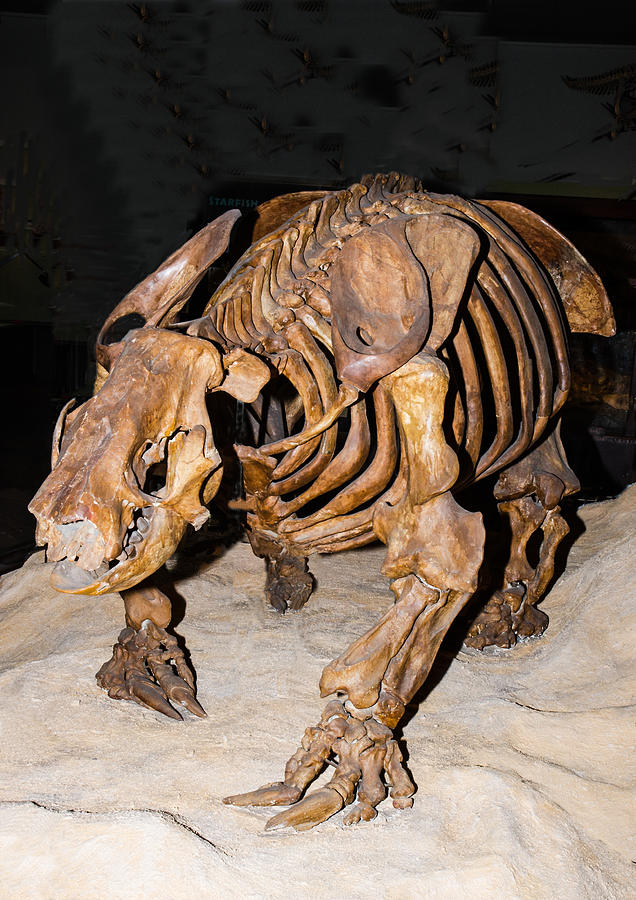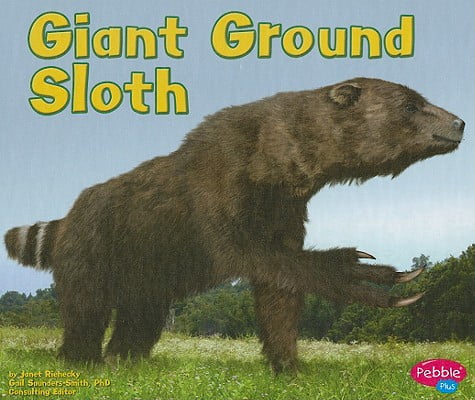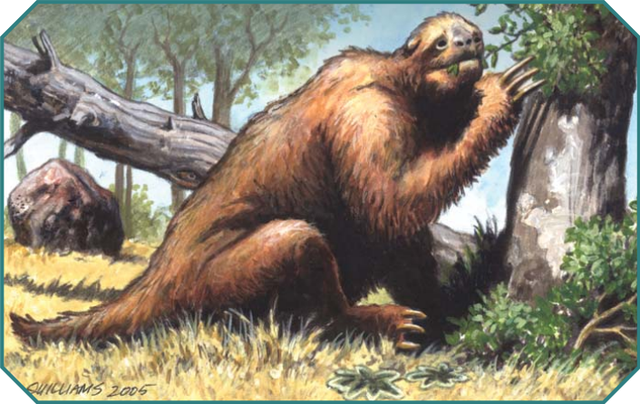

The smaller forelimbs armed with huge claws were most likely used to strip leaves and bark from trees. Unlike their much smaller arboreal relatives, the modern two- and three-toed sloths (Choloepus and Bradypus spp.), the giant ground sloths were terrestrial, and skeletal evidence indicates that despite their massive size they were able to stand up on their hind legs using their stout tails for balance (Casinos, 1996). Next to a giant ground sloth, a 500-pound grizzly bear would seem puny in comparison. These creatures, weighing several tons, were some of the largest mammals ever to walk the earth. Several species of the genus Megatherium inhabited North and South America. The exact cause of the Late Pleistocene megaherbivore extinctions remains a matter of debate, but the timing of these extinctions, following so quickly upon the heels of man's arrival, suggests more than mere coincidence. Shortly after humans entered the scene, the giant sloths disappeared from the New World's cast of characters, as did mammoths (Mammuthus spp.), the big-horned Bison antiquus, and many other large mammals. Unfortunately the Corps of Discovery and subsequent expeditions only served to prove that the mightiest beasts the New World had ever seen had already passed into history.Giant ground sloths (Megatherium and Ere-motherium spp.) roamed the Americas at the end of the last ice age. Inspired by fossil discoveries, Jefferson believed that there may have been huge creatures still living in the western wilderness, and even instructed Lewis and Clark to look for giant sloths, mammoths and even camels during their exploration of the Louisiana purchase. They were mostly quadrapedal (walking on four legs), but they could stand on their hind legs to reach up for food. In fact, the diet of giant ground sloths caused so much wear and tear that their teeth needed to continuously grow so that they didn’t wear away. Looking at those giant claws and big, wide jaws it kind of makes sense that Jefferson thought these animals were fierce carnivores, but their intimidating size and long claws actually allowed them to browse for low-hanging leaves in trees and their big teeth were designed for crushing rough plant material. Scary…? Well, Me galonyx would have looked much like it. Take a look at the skeleton of Eremotherium in our Hall of Paleontology. Cuvier had identified the animal as a relative of modern sloths, nothing like a big cat!


However, it was later discovered that an animal similar to M egalonyx had already been described by George Cuvier from remains discovered in Paraguay. Jefferson initially came to the same conclusion and described the remains as such in his correspondence with other members of the APH. Not much to go on… Taking into account those ferocious looking claws, Colonel Stewart suggested in his letter that the bones might belong to a giant lion, tiger or other big cat. The bones, which were sent to Jefferson by Colonel John Stewart of Greenbriar County (present day West Virginia) included partial arm and leg bones and some bones from the hand including three giant claws. Megalonyx, the name coined by Jefferson for the creature, simply means “great claw”. Those bones would turn out to belong to Megalonyx, the first giant ground sloth to be discovered in North America.Īt that time though, Jefferson didn’t know it was a sloth.

to take the oath of office as Vice President of the United States in 1797 he carried with him a wagon load of fossils to present to the American Philosophical Society, of which he would be elected president the same year. Thomas Jefferson was not only a great politician, he was a paleontologist too. It may seem like a stretch to connect the two, but in fact it was Thomas Jefferson who identified the first giant sloth found in North America, a cousin of E remotherium called Megalonyx. Thomas Jefferson, the great statesman who celebrates his 274th birthday today, roamed North America 200 years ago. Eremotherium, the species of giant ground sloth that we have on display in our Hall of Paleontology, roamed North America 20,000 years ago.


 0 kommentar(er)
0 kommentar(er)
